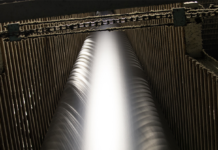LINER INTEGRITY SURVEY COURSES
On 12 March, 17 invited people from as far as the UK, attended the first joint TRI/Environmental – I-CORP INTERNATIONAL course on geoelectric Liner Integrity Surveys (LIS) in Austin, Texas. A half-day classroom session taught by Dr. Ian D. Peggs was followed by a half day of test surveying in three specially constructed cells with exposed, water-covered, and soil-covered liners. The exposed liner, used for water lance surveying was built over four different sub grades; geonet, conductive geotextile, conductive geomembrane (conductive side up, and with a seam), and GCL with a joint. The differences between each, and the effects of welds and joints, were quite apparent to those performing the surveys.
Surveys were performed on artificial calibration holes then on holes in the actual liners. A 5 mm diameter hole in the soil-covered liner when surveyed by Peggs generated the required characteristic signal shown below, indicating that the hole could be detected from a distance of about 5 ft. The signal generated by the participants was not quite as well-defined. Boundary conditions were changed such that significant current flowed around the edge of the cell, thereby demonstrating the significant loss of sensitivity that results.

Characteristic signal only generated by a leak
The classroom session describing the history, theory, practice, boundary conditions, and limitations of electrical survey techniques concluded with an outline of new technologies for locating leaks in bottom liners and landfill caps.
The need for such an accreditation course has arisen with the increasing acceptance of electrical integrity surveys as the final component of liner CQA by engineers and regulators. Some states are requiring such surveys. In addition, equipment packages for the different types of surveys are now commercially available. The class, the first of its kind, presented a unique opportunity for the attendees to learn the about the equipment and procedures associated with this work. For those desiring formal credentials for the performance of liner integrity surveys, the indoor and outdoor classroom work represented the first part of an accreditation path based on designed curriculum. The second part of accreditation consists of field guidance and monitoring for one or two days during a student’s first commercial survey project.
TRI and I-CORP have jointly formed the TRI-CORP Liner Integrity Center (T-CLIC) to perform research, development, education, and training in matters that contribute to the improved performance of geosynthetic containment systems.
TRI-CORP would like to thank GSE, Tarkett Sommer, R.T. Clark and Leak Sensors for the provision of liner materials and equipment.
A second course for a maximum of 20 registrants is planned for 7 and 8 June 2004. This session will start with a 1 hr practical demonstration in the water-covered cell, a half day in the classroom, then a full day with registrants performing surveys in each of the three test cells. For further information and to register contact Melissa Hunter (TRI) at 512 263 2101 (800 880 8378 in US), or Ian D. Peggs (I-CORP) at 561 369 0895, or download information directly at www.GeosyntheticTesting.com.
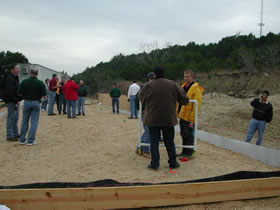
Performing soil-covered liner integrity surveys during TRI-CORP’s electrical liner integrity (leak location) survey course.
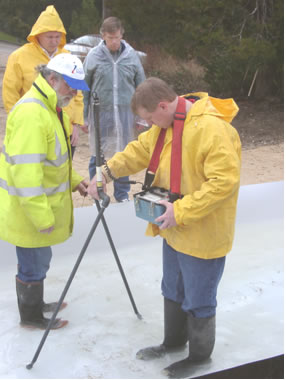
Jeff Blum of STS Consultants performing a trial survey on the water-covered liner test cell.
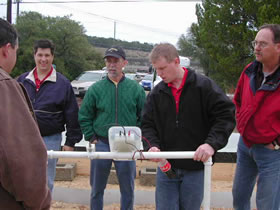
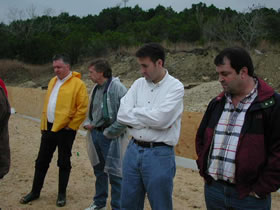
Course attendees checking potential readings during the survey. Seventeen registrants, from as far as the UK, attended the TRI-CORP Liner Integrity Center’s (T-CLIC) inaugural course, organized by Sam Allen at TRI on 12 March 2004. Led by Ian D. Peggs, a half- day of classroom sessions was followed by a half-day of test cell surveys on three custom built cells; water-covered, soil-covered, and exposed liner cells.
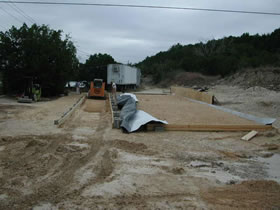
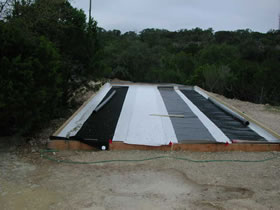
Photo left: Preparing the water covered liner adjacent to the soil covered cell.
Photo right: Secondary liner covered by (from left to right) conductive geotextile, GCL, conductive geomembrane, and geonet before primary liner placed for exposed liner water lance survey trials.
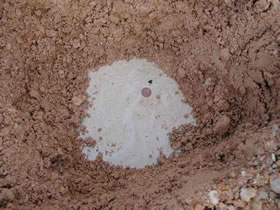
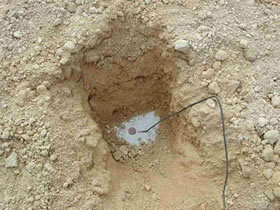
Photo left: Calibration hole next to a one-cent coin.
Photo right: Artificial calibration hole provided by exposed wire. Registrants performed their own surveys on a calibration cell and actual 2 mm leak in a single liner covered by water. On a soil-covered single liner they performed surveys over an artificial calibration hole connected into the circuit in two different ways, and over a 0.25 in hole in the liner with good boundary conditions and with two different types of poor boundary conditions. An exposed double liner with four different substrates under the primary liner was surveyed using the water lance technique.
The four substrates were a simple geonet, a GCL with an overlap, a conductive geomembrane with the conductive side up (also containing a weld), and a conductive geotextile. This provided an excellent comparison of the performance characteristics of the different types of lining systems. It is expected that there will be several more such courses leading to accreditation of technicians for performing electrical surveys.
T-CLIC will be developing other technologies to help assure liner integrity and performance which will be passed on to the industry. T-CLIC would like to thank GSE (Houston) and Tarkett Sommer (France) for providing lining system materials, and R.T. Clark (Oklahoma) and Leak Sensors (Connecticut) for providing additional power supplies and meters respectively.

